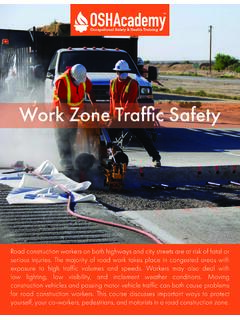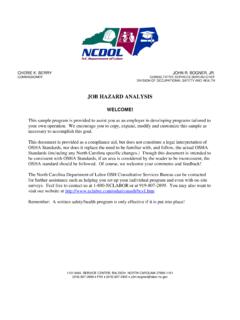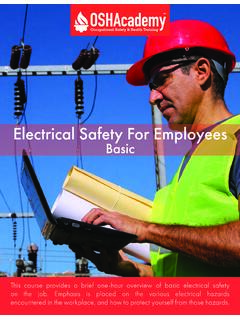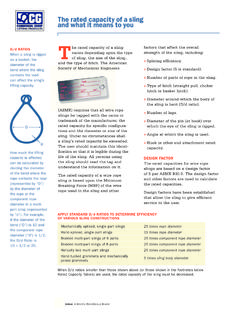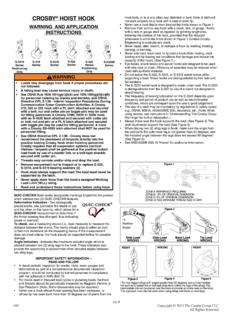Transcription of Hoisting & Rigging Fundamentals - oshatrain.org
1 Hoisting and Rigging Fundamentals for Riaaers and ODerators Pendant Control - Components TR244C, Rev. 5 December 2002 TR244C Rev . 5 TABLE OF CONTENTS INTRODUCTION .. ii Hoisting AND Rigging OBJECTIVES .. 1 WIRE ROPE SLINGS .. 2 SYNTHETIC WEBBING SLINGS .. IO CHAINSLINGS .. 14 METAL MESH SLINGS .. 18 SPREADER BEAMS .. 19 Rigging HARDWARE .. 22 INSPECTION TAG .. 39 CRITICAL LIFTS .. 40 GENERAL Hoisting AND Rigging PRACTICES .. 44 HANDSIGNALS .. 64 INCIDENTAL Hoisting OPERATOR OBJECTIVES .. 68 HOISTS .. 69 OVERHEAD AND GANTRY CRANES .. 71 MOBILECRANES .. 77 APPENDIX .. 81 i TR244C Rev. 5 INTRODUCTION Hoisting AND Rigging PROGRAM Safety should be the first priority when performing lifting operations. An understanding of the capabilities and limitations of the equipment will support this. The safety policy lf It s Not Safe, Don t Do It is important not only for your safety, but the safety of your coworkers.
2 The material outlined in this manual outlines the requirements of the DOE Hoisting and Rigging program. It requires persons who perform Rigging or operate Hoisting equipment to be trained to ensure that the personnel are competent to perform the operation. The qualification is for a period the three years. The training requires a written exam and practical demonstration. The requirements for operator training and qualification can be reviewed in the DOE Hoisting and Rigging Manual. TR244C Rev. 5 Hoisting AND Rigging OBJECTIVES KNOWLEDGE OBJECTIVES Explain the qualification requirements of the Rigging Training Program. Demonstrate how to calculate the load on the sling using the load angle factor for various load angles. Explain the proper use and limitations of the various Rigging equipment and hardware (wire rope, synthetic web slings, shackles, eyebolts, hooks, etc.). Identify the components and describe the characteristics of wire rope and synthetic slings.
3 Describe and state what an ordinary lift and critical lift is. Explain the responsibilities of the Person-ln-Charge (PIC) and designated leader. Explain safe working practices to consider when performing Hoisting and Rigging . State the requirements for routine and periodic inspections. State the proper hand signals used during lifting operations. 1 Page 1 of 86 TR244C Rev. 5 WIRE ROPE SLINGS Cqre 2 Wire rope is made up of three basic parts: the core, the wire, and the strand. Wire Rope consists of three components (1): The CORE is the center of the wire rope. The core serves as the foundation to hold the rope together. There are three types of cores: Fiber - synthetic or sisal, which is the weakest, Strand - the core is a wire strand, just like the other strands of the rope. Mependent Wire Rope (IWRC) -this is a separate wire rope. It is the strongest of the three types. The core provides 7-1/2% strength of the wire rope.
4 This is the core used in the wire rope slings provided on site. The WIRE is the basic unit of the wire rope. The wires form the strand. Most wire is high carbon steel, but other material types are available . The STRAND is made up of a specific number of wires, laid helically around a wire core. The most common type used at WVNS and in industry is 6 x 19. This is six strands comprised of approximately 19 wires (2), but may have 16 through 26 wires per strand. It has a good combination of flexibility and wear resistance. 3 6x19 construction. The larger wires on the outside of each strand resist wear. Page2of 86 TR244C Rev. 5 Right by. Regular Lay Rghl Lay. Lang Lay Let7 Lay - RegLbrby 4 The term rope lay signifies the direction of rotation of the wires and the strand (3). Rotation is either to the right (clockwise) or left (counterclockwise). The standard is right regular lay. Left-lay rope is for special-purpose applications.
5 The lay-length is the distance measured along a rope in which a strand makes one complete revolution around the axis (4). Wire rope slings have great strength combined with flexibility. They do not wear as rapidly and the indication of broken wires and appearances show its true condition. Wire rope should be protected with softeners or blocking when used at corners or sharp bends. These softeners (5) are available at the tool crib. It's a good rule to make sure that the length of the arc of contact of the rope is at least equal to one rope lay (above seven times the rope diameter). This is the most common cause of damage to wire rope. Practice proper Rigging and use softeners at corners or sharp bends. This is especially important when the load approaches the capacity of the Rigging . 5 6 TC: I Page3of 86 TR244C Rev. 5 FATIGUE RESISTANCE Fatigue resistance involves metal fatigue that make up a rope.
6 To have high fatigue resistance, wires must be capable of bending repeatedly under stress - as when a rope passes over a sheave. increased fatigue is achieved in a rope design by using a large number of wires. It involves both the basic metallurgy and the diameters of wires. In general, a rope made of many wires will have greater fatigue resistance than a same-size rope made of fewer larger wires, because smaller wires have greater ability to bend as the rope passes over sheaves or around drums. To overcome the effects of fatigue, ropes must never bend over sheaves or drums with a diameter so small as to kink wires or bend them excessively. There are precise recommendations for sheave and drum sizes to properly accommodate all sizes and types of ropes. Every rope is subject to metal fatigue from bending stress while in operation, and therefore, the rope's strength gradually diminishes as the rope is used.
7 Page 4 of 86 TR244C Rev. 5 SWL inspection Tags: Bridle Sling Description Inspection Date - Expiration Dat rcrlwtBI Regular Straight Sling Description WVNS SIN leg II STRENGTH Wire rope strength is usually measured in tons of 2,000 pounds. The catalog term "Breaking Strength" -- is the nominal strength given the rope by engineers. When put under tension on a test device, new ropes will actually break at a figure equal to, or higher than, the catalog figure. The catalog figure applies to new, unused rope. A rope should never operate at the catalog strength . During its useful life, a rope loses strength gradually due to natural causes such as surface wear and metal fatigue. Therefore, a Factor of Safety is applied during the selection of a rope in order to build service life into a rope installation. Page5of 86 TR244C Rev. 5 Sling Eye Design the Did Ratio is expresse Sling eyes are designed to provide what amount to "small inverted slings" at the ends of the sling body.
8 Therefore, the width of the eye opening will be affected by the same general forces which apply to legs of a sling rigged as a basket. A sling eye should never be used over a hook or pin with a body diameter larger that the natural width of the eye. Never force an eye onto a hook. On the other hand, the eye should always be used on a hook or pin with at least the nominal diameter of the rope-since applying the D/d Ratio shows an efficiency loss of approximately 50% when the relationship is less then 1/1 . D/d Ratios Apply to Slings When rigged as a basket, diameter of the bend where a sling contacts the load can be a limiting factor on sling capacity. Standard D/d ratios-where "D" is the diameter of the bend, and "d" the diameter of the rope-are applied to determine efficiency of various sling constructions, as indicated at left: TC: 1 Page 6 of 86 TR244C Rev. 5 Choker Hitch Rated Capacity Adjustment For wire rope slings in choker hitch when angle of choke is less than 135 degrees.
9 When a choker hitch is drawn tight at an angle of less than 120 degrees, the Choker Hitch Rated Capacity shown in the sling Rated Capacity Tables must be reduced to allow for loss of Rated Capacity. In controlled tests, where the angle was less than 120 degrees, the sling body always failed a the point of choke when pulled to destruction. Allowance for this phenomenon must be made anytime a choker hitch is used to shift, turn or control a load, or when the pull is against the choke in a multi-leg lift. Page7of 86 TR244C Rev. 5 6 Inspection FREQUENT (PRE-USE) INSPECTION Broken WlreS Slings shall be visually inspected by the person using the sling each day of their use. This visual observation should be concerned with discovering damage that may be an immediate hazard. Severe wear due to Be sure to be aware of wire ropes in acid type environments. Such an environment can have a rapid corrosive affect on the wire rope.
10 Kinks abrasion or scraping Kinking is caused by loops that have been drawntoo tightly as a result of improper handling. Kinks are permanent distortions and will require the rope or the damaged Birdcaging section to be removed from service. Broken or damage to end attachments The following should be looked for in a pre-use inspection: 1) Broken wires. 2) Severe localized abrasion or scraping. 3) Kinking, crushing, birdcaging, or any other damage resulting in distortion of the rope structure. 4) Evidence of heat damage. 5) End attachments that are cracked, deformed, or worn to the extent that the strength of the sling is substantially affected . 6) Severe corrosion. Review in Section of the DOE H&R Manual. Subsection I I. Wire Rope Slings. Page8of 86 TR244C Rev. 5 REVIEW QUESTIONS WIRE ROPE 1. The core of wire rope is the center and serves to provide support and maintain the position of outer strands.




